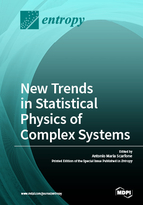New Trends in Statistical Physics of Complex Systems
A special issue of Entropy (ISSN 1099-4300). This special issue belongs to the section "Statistical Physics".
Deadline for manuscript submissions: closed (30 April 2018) | Viewed by 56560
Special Issue Editor
Interests: nonextensive statistical mechanics; nonlinear fokker-planck equations; geometry information; nonlinear schroedinger equation; quantum groups and quantum algebras; complex systems
Special Issues, Collections and Topics in MDPI journals
Special Issue Information
Dear Colleagues,
A challenging frontier in statistical physics concerns the study of complex and disordered systems. An interesting aspect of complex systems is the emergence of self-organization, which often drives the system in a metastable configuration, typically far from the thermodynamic limit, where the equilibrium distribution differs significantly from the Boltzmann-Gibbs exponential one.
Complex systems are not necessarily composed of many entities. They can be small systems with few entities but characterized by an elevated level of interconnection and interaction between the parts that exhibit a richer global free-scale dynamic. This gives rise to collective emergent behaviors of the entire system that are no more recognized in the properties and in the behavior of the single individual entities. In this ground, the methods of statistical physics in understanding complex systems have been very promising.
The aim of this Special Issue is to encourage researchers to present original and recent developments on complex and disordered systems and their applications to physical and physical like systems. For instance, applications of the statistical complex systems range from small systems to nano systems, from molecular biology to micromechanics, networks structures and (multi)-fractal phase space to new results in stochastic thermodynamics. Other good examples may be found in economic and social systems.
Prof. Dr. Antonio Maria Scarfone
Guest Editor
Manuscript Submission Information
Manuscripts should be submitted online at www.mdpi.com by registering and logging in to this website. Once you are registered, click here to go to the submission form. Manuscripts can be submitted until the deadline. All submissions that pass pre-check are peer-reviewed. Accepted papers will be published continuously in the journal (as soon as accepted) and will be listed together on the special issue website. Research articles, review articles as well as short communications are invited. For planned papers, a title and short abstract (about 100 words) can be sent to the Editorial Office for announcement on this website.
Submitted manuscripts should not have been published previously, nor be under consideration for publication elsewhere (except conference proceedings papers). All manuscripts are thoroughly refereed through a single-blind peer-review process. A guide for authors and other relevant information for submission of manuscripts is available on the Instructions for Authors page. Entropy is an international peer-reviewed open access monthly journal published by MDPI.
Please visit the Instructions for Authors page before submitting a manuscript. The Article Processing Charge (APC) for publication in this open access journal is 2600 CHF (Swiss Francs). Submitted papers should be well formatted and use good English. Authors may use MDPI's English editing service prior to publication or during author revisions.
Keywords
-
generalizations of statistical mechanics
-
fractional dynamics
-
non-equilibrium processes
-
stochastic processes
-
quantum and small systems
-
collective phenomena in biological, economic and social systems
Benefits of Publishing in a Special Issue
- Ease of navigation: Grouping papers by topic helps scholars navigate broad scope journals more efficiently.
- Greater discoverability: Special Issues support the reach and impact of scientific research. Articles in Special Issues are more discoverable and cited more frequently.
- Expansion of research network: Special Issues facilitate connections among authors, fostering scientific collaborations.
- External promotion: Articles in Special Issues are often promoted through the journal's social media, increasing their visibility.
- e-Book format: Special Issues with more than 10 articles can be published as dedicated e-books, ensuring wide and rapid dissemination.
Further information on MDPI's Special Issue polices can be found here.







